Key Takeaways
Discover how schools honor their all-time goal leaders in soccer, hockey, and football with modern digital recognition displays. Learn to celebrate scoring milestones effectively.
Understanding All-Time Goal Leader Recognition
All-time goal leaders represent the pinnacle of offensive achievement in sports programs. These athletes consistently find ways to score throughout their careers, accumulating statistics that set them apart from their peers and establish benchmarks for future generations.
What Makes Goal-Scoring Achievement Significant
Goal-scoring milestones carry special weight because they directly determine game outcomes. Unlike defensive statistics or support metrics, goals represent the ultimate objective in sports like soccer and hockey—putting the ball or puck in the net.
Key Elements of Goal-Scoring Excellence:
- Consistency: Scoring regularly across multiple seasons, not just isolated performances
- Clutch Performance: Delivering goals in critical moments when games hang in balance
- Skill Development: Evolving abilities as opponents adjust and competition intensifies
- Durability: Staying healthy enough to play in most games throughout a career
- Opportunity Creation: Positioning and movement that generates quality scoring chances
- Finishing Ability: Converting opportunities at higher rates than typical players
- Mental Toughness: Maintaining confidence through shooting slumps and defensive pressure
Athletes who become all-time goal leaders demonstrate all these qualities sustained across years of competition. A single 30-goal season is impressive; maintaining double-digit goal production across four seasons earns a permanent place in program history.
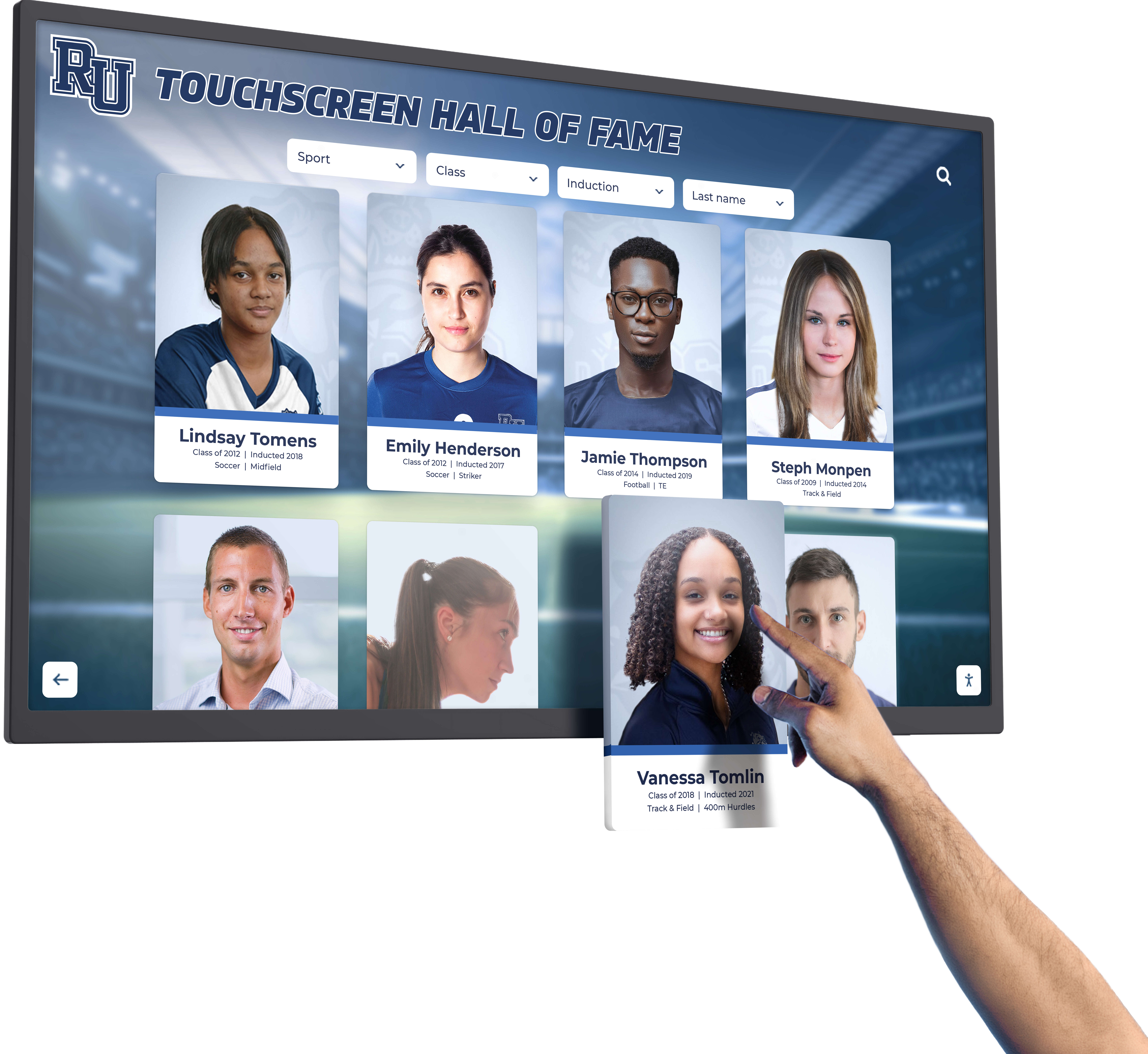
Sport-Specific Goal-Scoring Contexts
Different sports define goal-scoring achievement differently based on game structure, season length, and scoring frequency.
Soccer Goal-Scoring Benchmarks:
In high school soccer, seasons typically span 15-20 games with lower-scoring outcomes than other sports. Elite strikers might score 15-25 goals in exceptional seasons, while consistent scorers average 8-12 goals annually.
Career milestones in high school soccer commonly include:
- 25+ Career Goals: Solid contributor across multiple seasons
- 40+ Career Goals: Elite scorer demonstrating exceptional ability
- 50+ Career Goals: Program-defining achievement reserved for rare talents
- Career Points (Goals + Assists): Recognizing complete offensive contribution
Schools should track both goals and assists since soccer rewards playmaking equally with finishing. A midfielder creating 20 assists demonstrates offensive impact comparable to forwards scoring 20 goals.
Hockey Goal-Scoring Benchmarks:
Hockey seasons feature 20-30 games at the high school level, with higher scoring frequency than soccer but still emphasizing defensive play. Top scorers might record 25-40 goals in standout seasons.
Career milestones in high school hockey typically include:
- 50+ Career Goals: Significant achievement showing consistent production
- 75+ Career Goals: Elite status among program leaders
- 100+ Career Goals: Rare milestone few athletes reach
- Career Points (Goals + Assists): Critical metric in hockey where playmaking matters equally
Hockey’s emphasis on assists makes points totals even more important than goals alone. Many legendary players excel as playmakers rather than pure goal scorers.
Football Rushing and Scoring Milestones:
While football doesn’t use “goals” terminology, running backs and quarterbacks accumulate comparable offensive achievements through rushing yards, touchdowns, and total offense.
Career milestones in high school football include:
- 1,000+ Career Rushing Yards: Solid contributor across seasons
- 2,000+ Career Rushing Yards: Elite back demonstrating sustained excellence
- 3,000+ Career Rushing Yards: Program-defining achievement
- Career Touchdowns: Both rushing and receiving combined
- Career Total Offense: For quarterbacks combining passing and rushing
Solutions like digital record boards enable schools to track these diverse achievements across all sports systematically.
Traditional Recognition Methods and Their Limitations
For decades, schools have honored goal-scoring achievements through physical displays that, while well-intentioned, create significant practical challenges and limitations.
Physical Plaques and Record Boards
Traditional record boards typically consist of vinyl lettering or engraved plaques listing top scorers by season and career. These static displays face multiple problems:
Space Constraints: Physical walls have finite space. As programs accumulate history, difficult decisions emerge about which achievements to display and which to relegate to storage or archives.
Update Complexity: Changing records requires professional vinyl work, plaque ordering, or complete board replacement—processes taking weeks or months and costing hundreds to thousands of dollars per update.
Limited Information: Static displays accommodate only basic statistics—names, years, and totals. There’s no room for photos, achievement context, or personal narratives that make recognition meaningful.

Trophy Cases and Physical Displays
Trophy cases preserve physical awards and memorabilia but face similar limitations:
- Only items that fit in available space receive display
- Depth limitations mean back-row items become invisible
- Security concerns about valuable memorabilia
- No ability to provide context beyond basic labels
- Deterioration of materials over time requiring preservation efforts
Many schools discover that significant achievements end up in storage boxes rather than displayed because cases reach capacity—a disappointing outcome when accomplishments deserve celebration.
Modern Digital Recognition for Goal Leaders
Digital recognition technology eliminates traditional limitations while introducing capabilities that transform how schools celebrate scoring excellence.
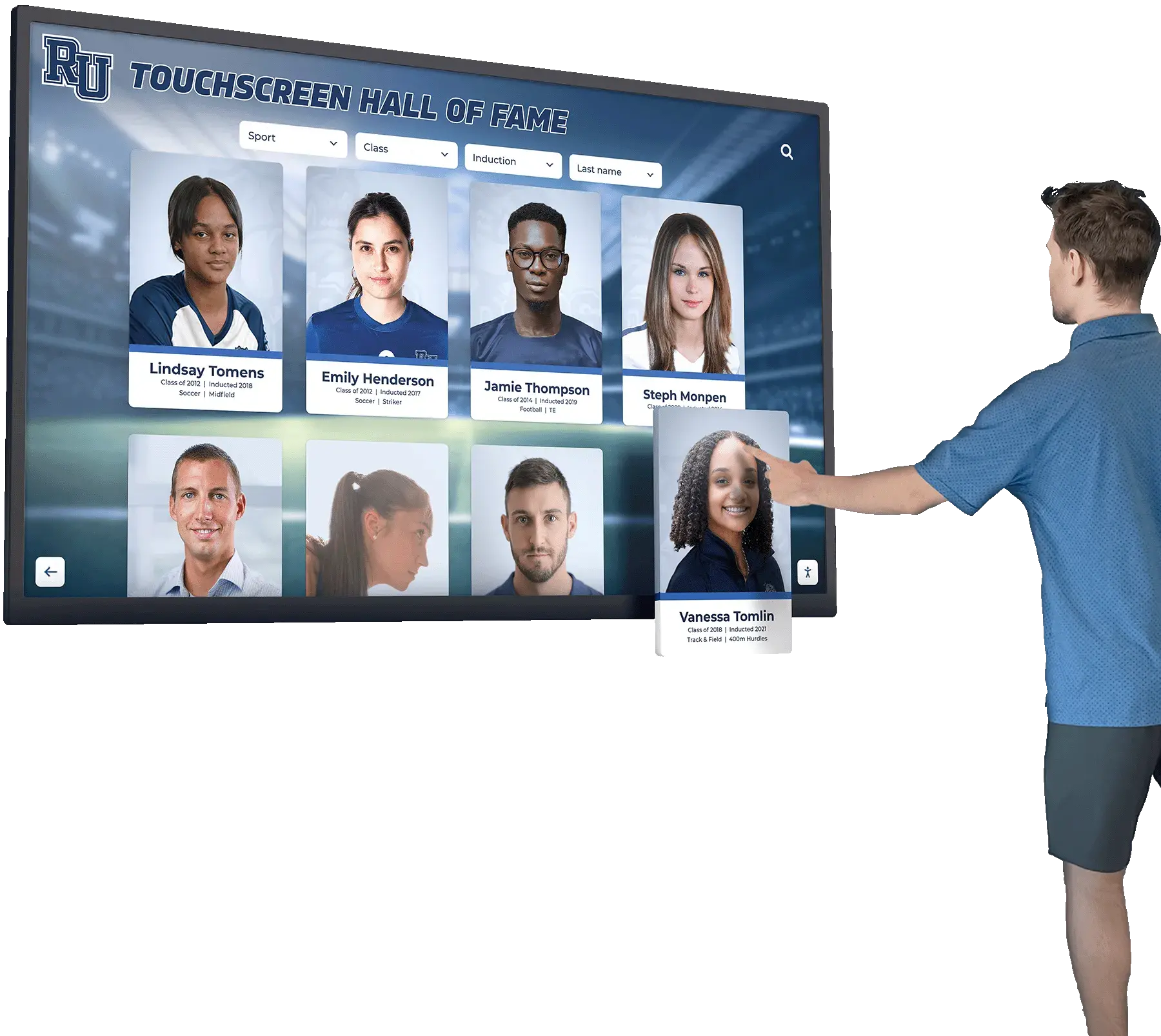
Unlimited Recognition Capacity
Perhaps the most transformative advantage of digital systems: unlimited capacity for recognizing achievements without space constraints forcing difficult prioritization decisions.
Comprehensive Recognition:
Digital platforms accommodate:
- All-time goal leaders across program history
- Season-by-season scoring leaders
- Single-game scoring records
- Career points leaders (goals + assists)
- Position-specific achievement categories
- Historical context and evolution of records
Schools can honor every achievement worthy of recognition without worrying about wall space, case capacity, or physical material costs for each new addition.
Real-Time Updates and Immediate Recognition
Modern digital displays enable instant recognition when athletes reach scoring milestones, eliminating frustrating delays between achievement and acknowledgment.
Instant Update Process:
When an athlete reaches a career scoring milestone:
- Athletic staff logs into cloud-based content management system from any device
- Selects “Add New Achievement” using intuitive templates
- Uploads photos and enters achievement details
- Publishes immediately—changes appear on displays within seconds
- Automated sharing to social media and web platforms amplifies celebration
This real-time capability means an athlete who scores their 50th career goal on Tuesday night can see their recognition displayed before leaving the stadium, with their achievement celebrated across digital platforms before the evening ends.
Systems like Rocket Alumni Solutions specifically designed for schools make these instant updates accessible to any staff member without requiring technical expertise.
Rich Multimedia Storytelling
Digital platforms enable recognition depth impossible with traditional static displays, transforming simple statistics into compelling achievement stories.
Comprehensive Goal Leader Profiles Include:
Career Statistics:
- Total career goals and scoring average per game
- Goals by season showing development progression
- Notable single-game performances and milestone moments
- Assists and points totals demonstrating complete offensive contribution
- Shooting accuracy and efficiency metrics when available
- Comparison to school and conference records
Achievement Timeline:
- Freshman season introduction and early development
- Year-by-year progression and statistical growth
- Junior and senior season peak performance periods
- Tournament and playoff contributions
- Record-breaking moments with game details
- Championship team participation
Multiple Photos and Videos:
- Action shots showing playing style and technique
- Milestone moment photos (50th goal, record-breaking performances)
- Team celebration photos with teammates and coaches
- Individual portraits and profile images
- Video highlight reels demonstrating scoring ability
- Post-game interview clips reflecting on achievements
Personal Narratives:
- Journey from youth programs through high school career
- Challenges overcome and obstacles conquered
- Impact of coaches, teammates, and family support
- Academic achievements alongside athletic excellence
- College plans and future athletic aspirations
- Messages of gratitude and inspiration for younger athletes
This multimedia richness creates emotional connections that simple name-and-number displays cannot generate, making recognition more meaningful and engaging for all audiences.
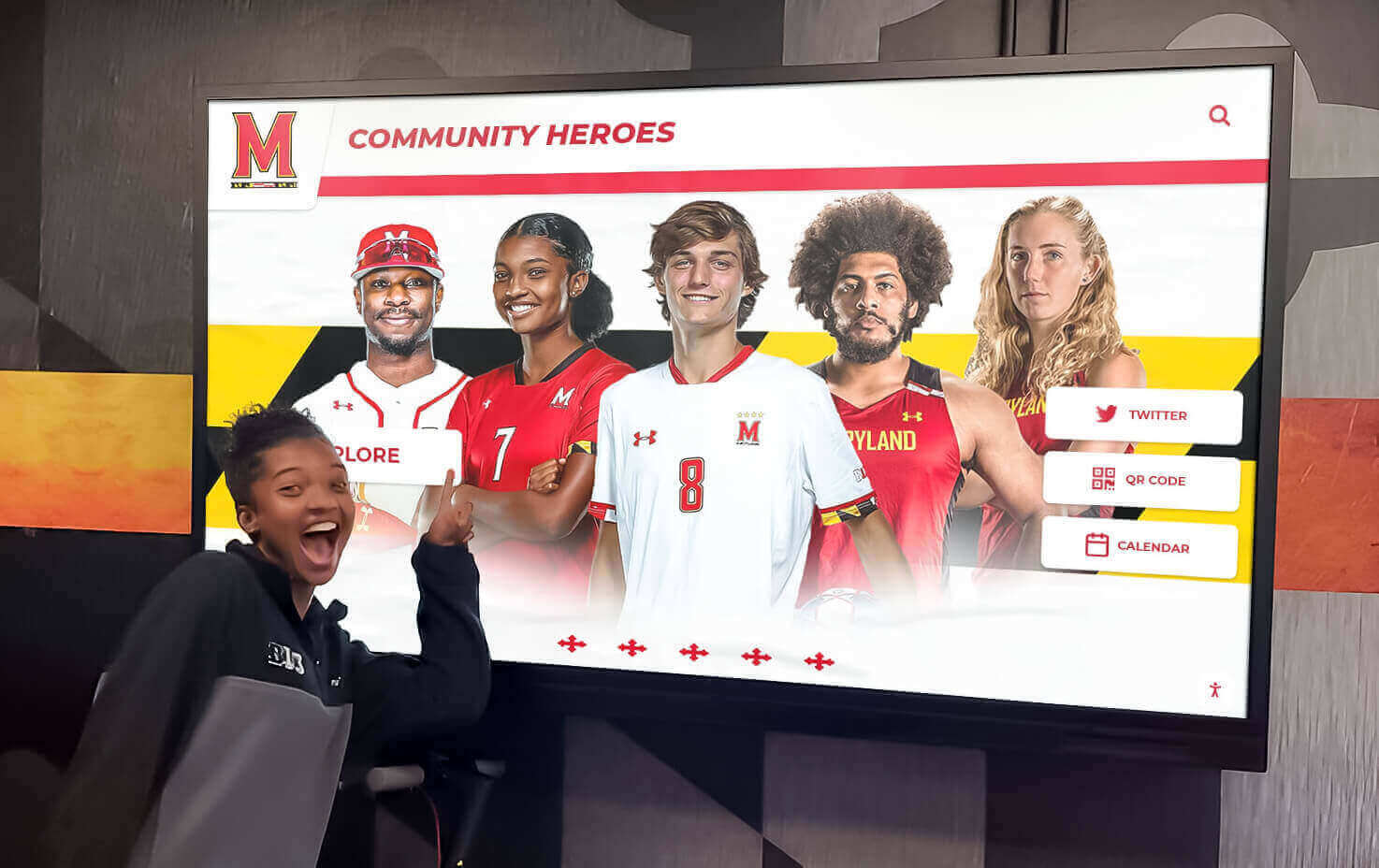
Implementing All-Time Goal Leader Recognition Programs
Schools can create comprehensive recognition systems celebrating scoring excellence through systematic planning and execution.
Historical Research and Documentation
Building complete goal-scoring archives requires systematic research documenting achievements throughout program history.
Research Sources:
- Historical Yearbooks: Team photos, rosters, and season summaries
- Newspaper Archives: Game reports, statistics, and achievement coverage
- Athletic Department Records: Statistical books and coaching records
- Alumni Outreach: Contact former players for memories and verification
- Coach Interviews: Gather institutional knowledge from long-time coaches
- Video Archives: Game footage providing both statistics and visual documentation
For programs with decades of history, this research represents significant investment but creates permanent institutional value preserving achievements that might otherwise be forgotten.
Schools should document not just goal totals but complete contexts—season records, team success during athlete’s tenure, notable performances, and memorable moments that statistics alone cannot capture.
Establishing Recognition Criteria
Clear standards ensure recognition remains meaningful while providing pathways for diverse achievements to receive appropriate acknowledgment.
Sample Recognition Tiers for Soccer:
- All-Time Top 10: Program’s career goal-scoring leaders throughout history
- 50 Goal Club: Athletes reaching 50+ career goals (rare achievement)
- 40 Goal Club: Next tier of elite scorers
- Season Leaders: Top scorers from each season regardless of career totals
- Single-Game Records: Highest goal totals in individual games
- Tournament Excellence: Top scorers in playoff and championship games
Sample Recognition Tiers for Hockey:
- All-Time Top 10: Career goal-scoring leaders
- 100 Point Club: Athletes reaching 100+ career points (goals + assists)
- 50 Goal Club: Pure goal-scoring achievement
- Season Leaders: Annual recognition for top performers
- Playoff Performers: Postseason scoring excellence
- All-Around Excellence: Leaders in multiple statistical categories
Sample Recognition Tiers for Football:
- All-Time Rushing Leaders: Career rushing yards rankings
- 2,000 Yard Club: Elite career rushing achievement
- Career Touchdown Leaders: Both rushing and receiving combined
- Single-Season Records: Annual rushing and scoring achievements
- All-Purpose Yards: Combined rushing, receiving, and return statistics
- Quarterback Total Offense: Passing and rushing yards combined
Frameworks like those described in football records recognition help athletic departments establish comprehensive criteria across all sports.
Content Development Strategy
Recognition program success depends on compelling, accurate content that engages audiences while authentically honoring athletes.
Phased Implementation:
Phase 1 - Foundation (Months 1-3):
- Current season rosters and statistics
- Recent 3-5 years of top scorers
- All-time career leaders across major categories
- Essential program milestones and records
Phase 2 - Enhancement (Months 4-8):
- Extended athlete biographies
- Historical research expanding decade coverage
- Video highlights and interviews
- Additional photos and multimedia content
Phase 3 - Complete Archives (Months 9-24):
- Comprehensive program history documentation
- Complete statistical databases
- Documentary-style profiles for significant figures
- Season-by-season documentation
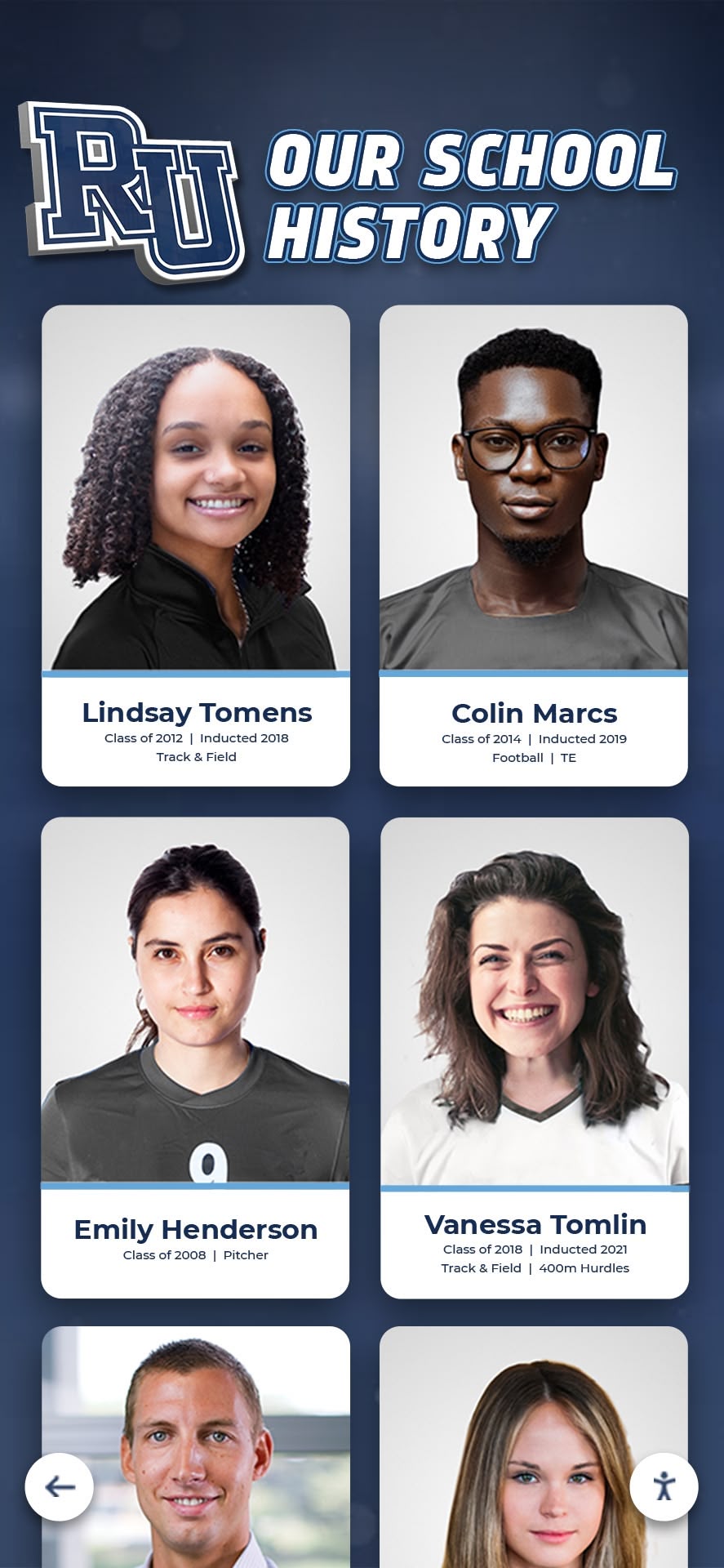
Creating Motivational Impact Through Recognition
Effective goal leader recognition serves purposes beyond simple acknowledgment—it motivates current athletes and shapes program culture.
Inspiring Current Athletes
Visible recognition of all-time goal leaders provides concrete targets that motivate athletes to pursue excellence.
When underclassmen see comprehensive displays documenting how previous scorers developed over their careers—8 goals as freshmen growing to 15 as sophomores, 20 as juniors, and 25 as seniors—they understand achievement pathways rather than viewing records as unattainable mysteries.
Motivational Framework:
Interactive displays help younger players:
- Browse profiles of top scorers understanding their development progressions
- View statistics showing that excellence builds gradually across seasons
- Calculate what production they need to reach milestone achievements
- See teammates and recent graduates they watched or knew personally
- Understand that sustained effort rather than instant dominance leads to records
- Visualize themselves potentially joining elite group of program leaders
This self-directed exploration creates personal motivation more effectively than abstract encouragement from coaches.
Guides on soccer all-time scorers recognition provide detailed frameworks for building these motivational systems.
Building Program Tradition and Identity
Comprehensive recognition of goal-scoring excellence contributes to broader program culture development.
Cultural Impact:
Visible recognition communicates:
- Individual achievement matters and receives lasting celebration
- Excellence sustained over years earns permanent acknowledgment
- Current players add their names to historical legacy
- Program honors those representing its values and standards
- Achievement requires both talent and character
- Tradition connects generations of athletes across decades
These implicit messages shape how athletes approach their careers, understanding they can earn recognition through sustained excellence that becomes part of permanent program history.
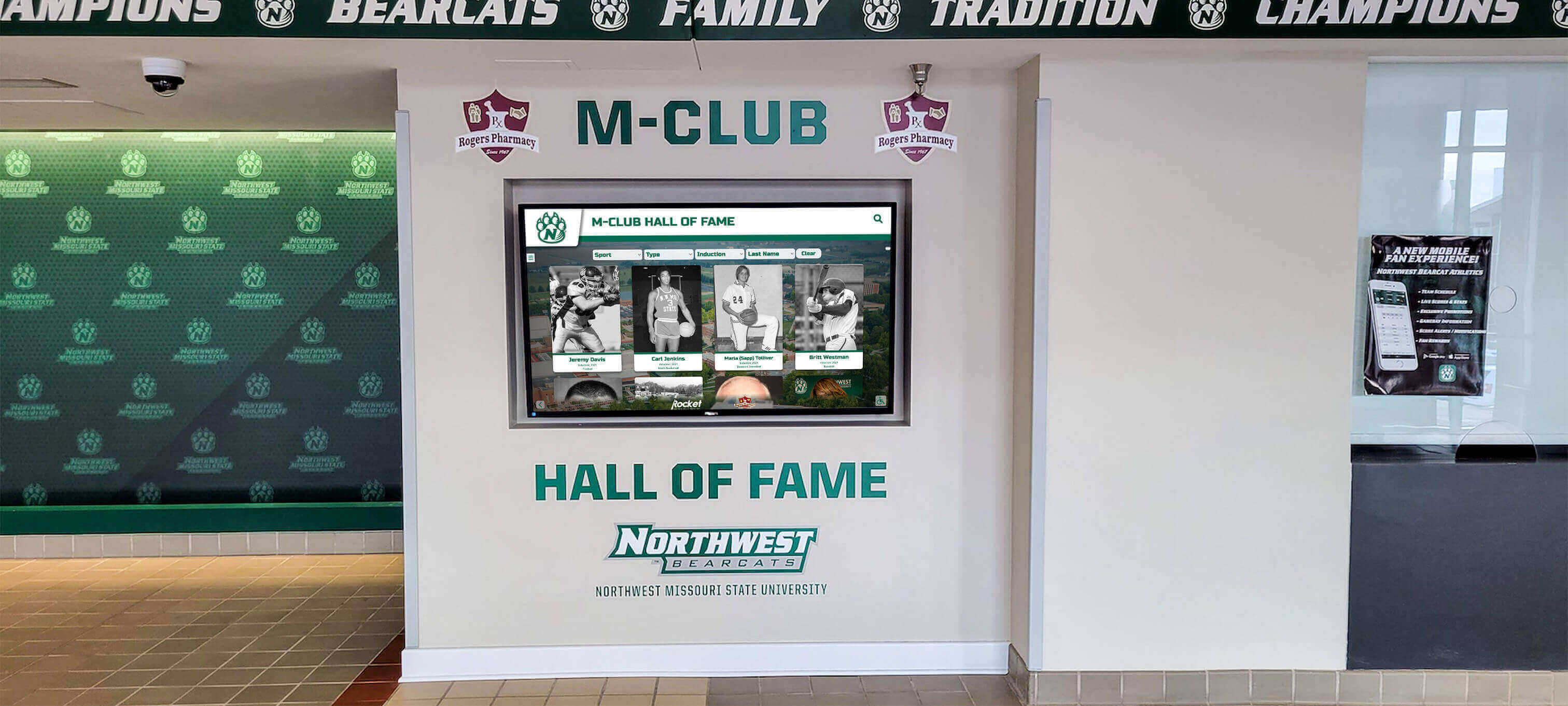
Technology Considerations for Digital Recognition
Successful implementation requires appropriate technology selections matching program needs and resources.
Hardware Selection
Commercial-grade displays designed for continuous operation ensure reliable performance in high-traffic athletic facilities.
Display Specifications:
- Screen Size: 43-75 inches depending on viewing distance and space
- Touch Technology: Responsive multi-touch supporting natural interaction
- Resolution: 1080p minimum for crisp text and image quality
- Brightness: 350-450 nits for well-lit gymnasium environments
- Durability: Commercial specifications rated for 16-24 hour daily operation
- Mounting: Professional wall-mount or freestanding kiosk options
- Connectivity: Reliable ethernet preferred over WiFi for stability
Consumer televisions typically fail within 18-24 months under school usage patterns. Commercial specifications deliver significantly lower total cost of ownership despite higher initial investment.
Software Platform Features
Purpose-built recognition platforms designed specifically for schools provide essential features generic systems lack.
Essential Platform Capabilities:
- Cloud-Based Management: Update content from any internet-connected device
- Intuitive Interface: No technical expertise required for content updates
- Template Systems: Pre-designed layouts ensuring professional appearance
- Search and Filtering: Athletes, years, sports, and achievement types
- Mobile Responsiveness: Content accessible on all device sizes
- Analytics: Usage tracking demonstrating engagement and value
- Security: Role-based access controls and automated backups
- Support: Responsive assistance from educational technology specialists
Resources on comprehensive sports record keeping help schools evaluate platform capabilities systematically.
Budget and Investment Considerations
Understanding costs helps schools plan recognition program implementations matching available resources.
Investment Components
Initial Setup ($10,000-$25,000):
- Hardware: Commercial touchscreen display, computer module, mounting ($5,000-$15,000)
- Software: Platform licensing, customization, training ($2,000-$5,000 first year)
- Content: Historical research, photo digitization, initial database ($3,000-$8,000)
- Installation: Professional mounting, connectivity, configuration ($1,000-$3,000)
Annual Operating Costs ($2,000-$5,000):
- Software Licensing: Platform access and support ($1,500-$3,000)
- Content Updates: Ongoing maintenance and additions ($500-$2,000)
- Hardware Warranty: Extended coverage beyond standard period ($500-$1,000)
Return on Investment:
Digital systems deliver value justifying investment through:
- Eliminated Update Costs: Traditional vinyl boards require $2,000-$5,000 annually for updates
- Reduced Labor: Digital updates take 30 minutes vs. 2-4 hours for physical changes
- Enhanced Recruitment: Visible recognition influences prospect decisions positively
- Space Efficiency: Single display consolidates recognition requiring 100+ feet of wall space
- Longevity: Commercial displays lasting 5-7+ years vs. traditional materials needing replacement every 3-5 years
Funding Strategies
Successful Funding Approaches:
- Athletic Booster Clubs: Dedicated fundraising campaigns for recognition projects
- Alumni Associations: Engagement of former athletes supporting current recognition
- Corporate Sponsorships: Local business partnerships with appropriate acknowledgment
- Naming Opportunities: Major donors receiving recognition for significant contributions
- Memorial Giving: Honoring deceased athletes or coaches through recognition programs
- Grant Applications: Educational technology foundations supporting innovation
- Phased Implementation: Starting with single display and expanding over time
Best Practices for Goal Leader Recognition
Successful programs implement recognition following proven approaches maximizing impact while maintaining authenticity.
Accuracy and Verification
Statistical accuracy forms the foundation of credible recognition programs.
Verification Processes:
- Cross-reference statistics from multiple sources when possible
- Acknowledge historical records containing uncertainty
- Document sources for statistical claims
- Correct errors promptly when discovered
- Establish procedures for disputed statistics
- Maintain complete edit history tracking all changes
Nothing undermines recognition credibility faster than obviously inaccurate statistics or careless errors in athlete information.
Inclusive Recognition Philosophy
While all-time leaders naturally receive prominent recognition, comprehensive programs celebrate broader achievement.
Balanced Recognition:
- Season leaders even when career totals don’t reach all-time lists
- Different achievement types (playmaking, clutch scoring, tournament performance)
- Improvement and development not just peak performance
- Team context showing collective success alongside individual achievement
- Character and leadership complementing statistical excellence
Inclusive approaches ensure recognition inspires all athletes rather than creating perception that only generational talents deserve acknowledgment.
Regular Content Updates
Recognition loses impact when displays contain obviously outdated information.
Update Schedule:
- Weekly During Season: Featured content highlighting current performances
- Post-Game: Notable achievements from recent games
- Monthly: Rotated historical content and athlete spotlights
- Seasonally: Current season statistics and standings
- Annually: New graduating seniors and final season records
- Ongoing: Enhanced profiles with additional multimedia
Regular refreshes communicate that recognition is current, ongoing, and comprehensive rather than historical and static.
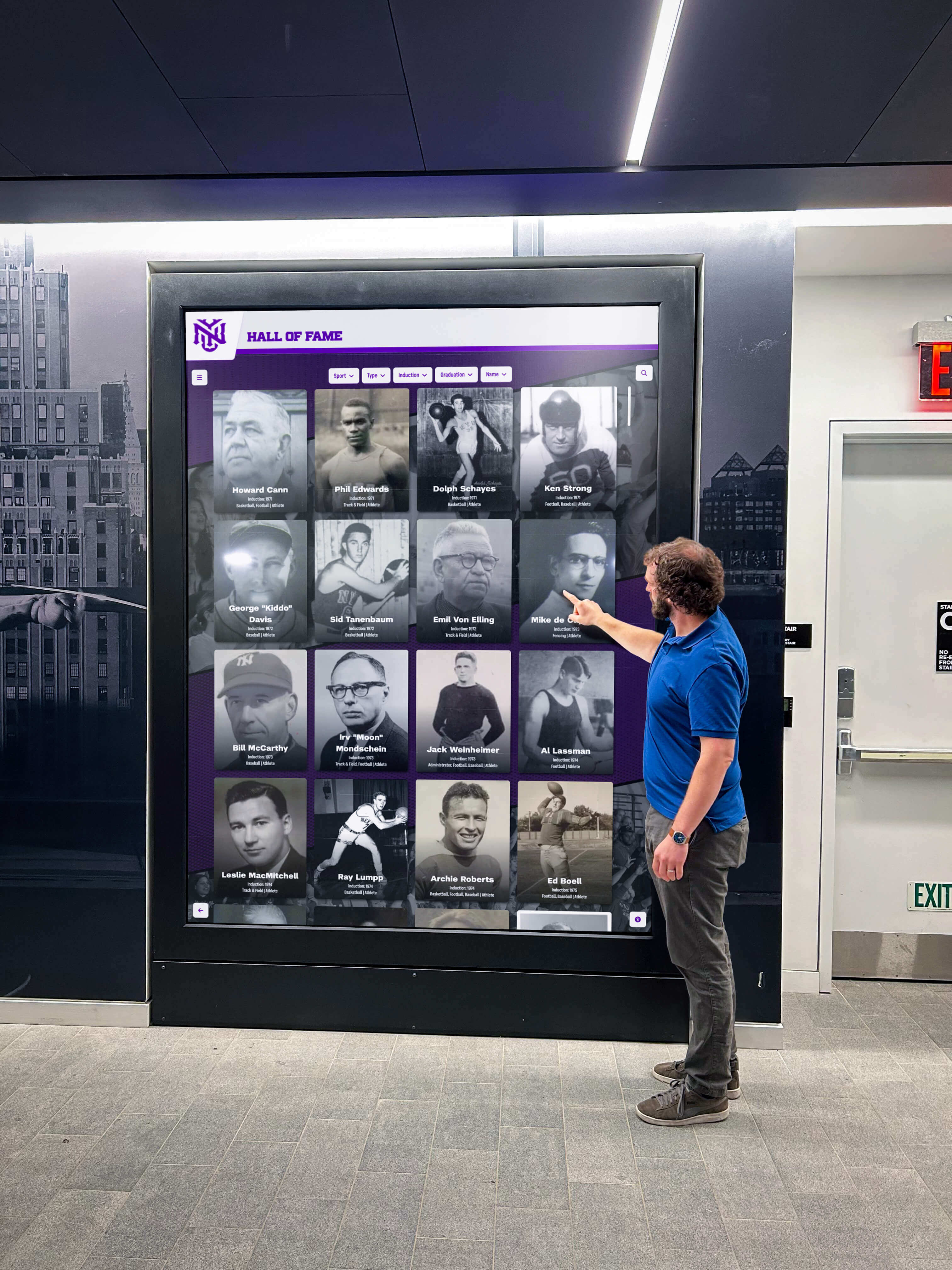
Conclusion: Honoring Scoring Excellence Through Modern Recognition
All-time goal leaders represent athletic excellence deserving recognition that matches achievement significance. Whether soccer strikers who accumulated 50+ career goals, hockey forwards who reached 100+ career points, or football running backs who rushed for 2,000+ yards, these athletes demonstrated rare consistency, skill, and dedication that inspire teammates and future generations.
Modern digital recognition systems enable schools to honor these achievements comprehensively, immediately, and permanently—moving beyond limitations of traditional plaques and trophy cases to create engaging experiences celebrating excellence while building program tradition.
Digital touchscreen displays eliminate space constraints allowing unlimited recognition without difficult prioritization, enable instant updates celebrating milestones immediately while excitement peaks, provide rich multimedia storytelling bringing achievements to life through photos and videos, and create permanent searchable archives preserving accomplishments for decades.
Schools implementing comprehensive goal leader recognition report enhanced athlete motivation and satisfaction, improved family engagement and school connection, streamlined recognition processes saving administrative time, equitable celebration across all sports programs, and preserved institutional history preventing achievement loss.
The next time an athlete in your school reaches a significant scoring milestone, they deserve recognition celebrating their accomplishment appropriately. Digital recognition systems ensure excellence receives the honor it has earned—creating celebration moments athletes and communities remember while building recognition traditions inspiring future scoring champions to pursue their own extraordinary achievements.
Ready to Transform Your Goal Leader Recognition?
Discover how modern digital recognition enables schools to celebrate all-time scoring leaders and other athletic achievements through intuitive touchscreen displays. Purpose-built platforms designed specifically for schools offer the simplicity athletic departments need with the power to create professional, engaging recognition that motivates athletes and builds program pride.
Visit Rocket Alumni Solutions to explore how digital recognition transforms milestone celebrations from delayed updates into immediate inspiration. Your scoring leaders deserve recognition that matches their achievements—permanent, professional, and powerful.





































